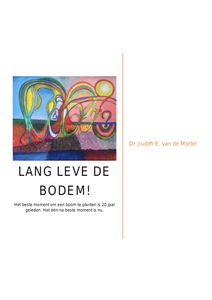In november 2018 overleed Frans Meijers; onderzoeker, lector, en levenspartner van Reinekke Lengelle. Reinekke en Frans werkten en schreven samen en hebben de narratieve methode Career Writing (loopbaanschrijven) ontwikkeld. In haar onlangs verschenen boek Writing the Self in Bereavement beschrijft ze haar leven met Frans. Ze vertelt ook over haar verdriet en combineert eigen ervaringen met huidig wetenschappelijk onderzoek over rouw. In dit artikel reageert ze op een aantal vragen die ze in eerdere interviews werd gesteld.
DOCUMENT

Inaugurele rede uitgesproken op 9 mei 2019 door Dr. J.E. (Judith) van de Mortel bij de benoeming tot lector “Gezonde plant op een vitale en duurzame bodem” aan HAS Hogeschool Venlo. De krant werd uitgegeven ter ere van de inaugurele rede. Dit deed ze op een bijzondere manier: alle genodigden gingen met een denkbeeldige tijdmachine vooruit naar het jaar 2030 waar ze Judith ontmoetten. Judith keek vervolgens terug naar het jaar 2019 en stelde dat ze hoopt dat de sector in de tussenliggende jaren bereikt heeft dat alle agrarische bodems in Nederland duurzaam beheerd worden door verschillende aanpakken te combineren. Om dit te illustreren schetste ze een beeld van hoe de agrarische onderneming er in 2030 uitziet. Met het lectoraat wil ze hieraan bijdragen. De krant is dan ook geschreven alsof het 9 mei 2030 is.
MULTIFILE

The nonlinearity induced by light-emitting diodes in visible light communication (VLC) systems presents a challenge to the parametrization of orthogonal frequency division multiplexing (OFDM). The goal of the multi-objective optimization problem presented in this study is to maximize the transmitted power (superimposed LED bias-current and signal amplification) for both conventional and constant envelope (CE) OFDM while also maximizing spectral efficiency. The bit error rate (BER) metric is used to evaluate the optimization using the non-dominated sorting genetic algorithm II. Simulation results show that for a BER of 1×10 −3 , the signal-to-noise ratio (SNR) required decreases with the guard band due to intermodulation distortions. In contrast to SNR values of approximately 13 and 25 dB achieved by traditional OFDM-based systems, the VLC system with CE signals achieves a guard band of 6% of the signal bandwidth with required SNR values of approximately 10.8 and 24 dB for 4-quadrature amplitude modulation (QAM) and 16-QAM modulation orders, respectively.
DOCUMENT
In this paper, we experimentally compare orthogonal frequency-division multiplexing (OFDM) and on-off keying (OOK) modulation in the context of the IEEE 802.15.13-2023 standard at bandwidths up to 50 MHz across a Li-Fi link with distances up to 5 m and a lateral offset up to 51°. Error vector magnitude (EVM) and bit error rate (BER) evaluations confirm that the high peak-to-average power ratio (PAPR) of OFDM limits the achievable transmission distance, but it offers higher data rates due to its higher spectral efficiency. Due to the lower PAPR, OOK-based Pulsed Modulation PHY (PM-PHY) shows a significantly higher link range. As the structure of the PM-PHY is based on OFDM symbols, the two solutions may also be combined to open a wider range of use cases for optical wireless communications.
LINK
This study presents a methodology designed to optimize various parameters of each access point within a Multiple-Input Single-Output (MISO) Visible Light Communication (VLC) system. The primary objective is to enhance both power and spectral efficiencies. A MISO-VLC model is presented based on experimental evaluations and a problem formulation considering intermodulation distortions based on Orthogonal Frequency Division Multiplexing modulation. A Hybrid Multi-Objective Optimization (HMO) approach is proposed, combining the Non-Sorting Genetic Algorithm III (NSGA-III) and the Multi-objective Grey Wolf Optimization (MOGWO). The proposed HMO's success was validated by a 66 % reduction in transmitted power, maintaining the Error Vector Magnitude (EVM) performance metrics even at lower power transmission levels and minimizing the guard band to its lower bound.
DOCUMENT